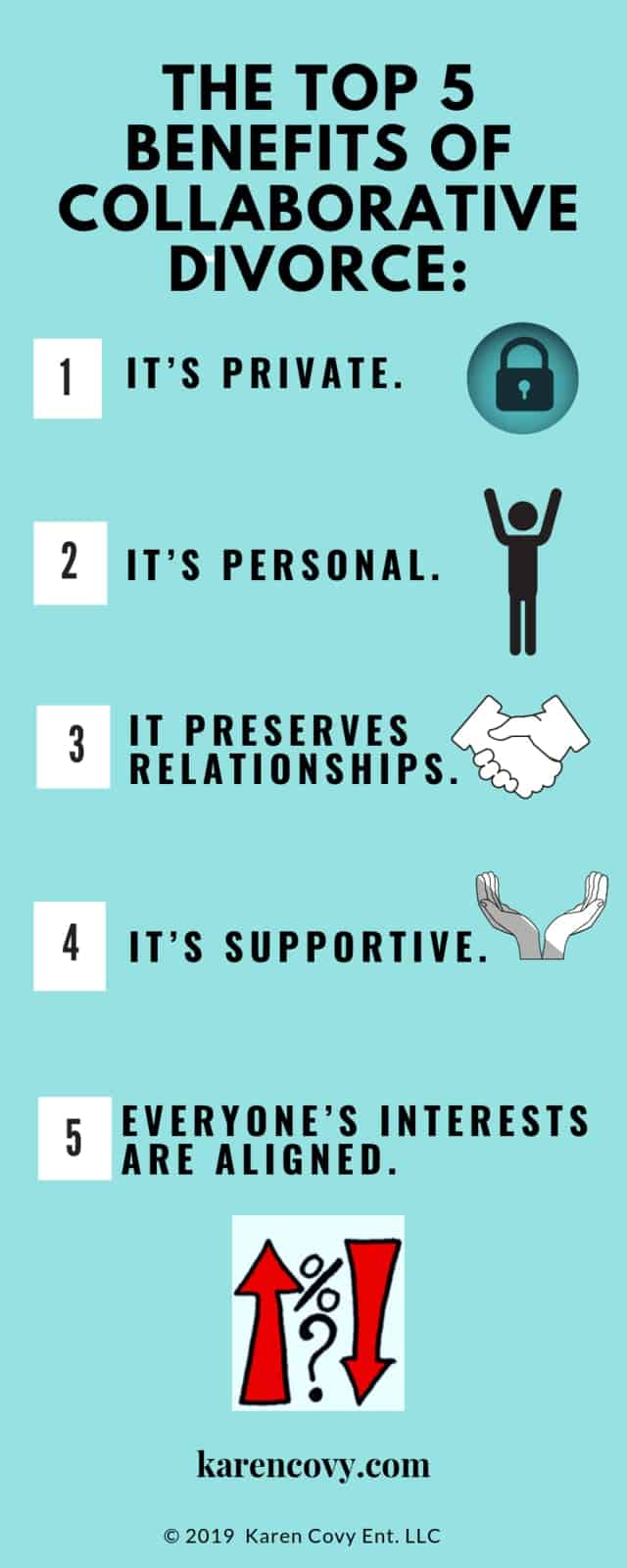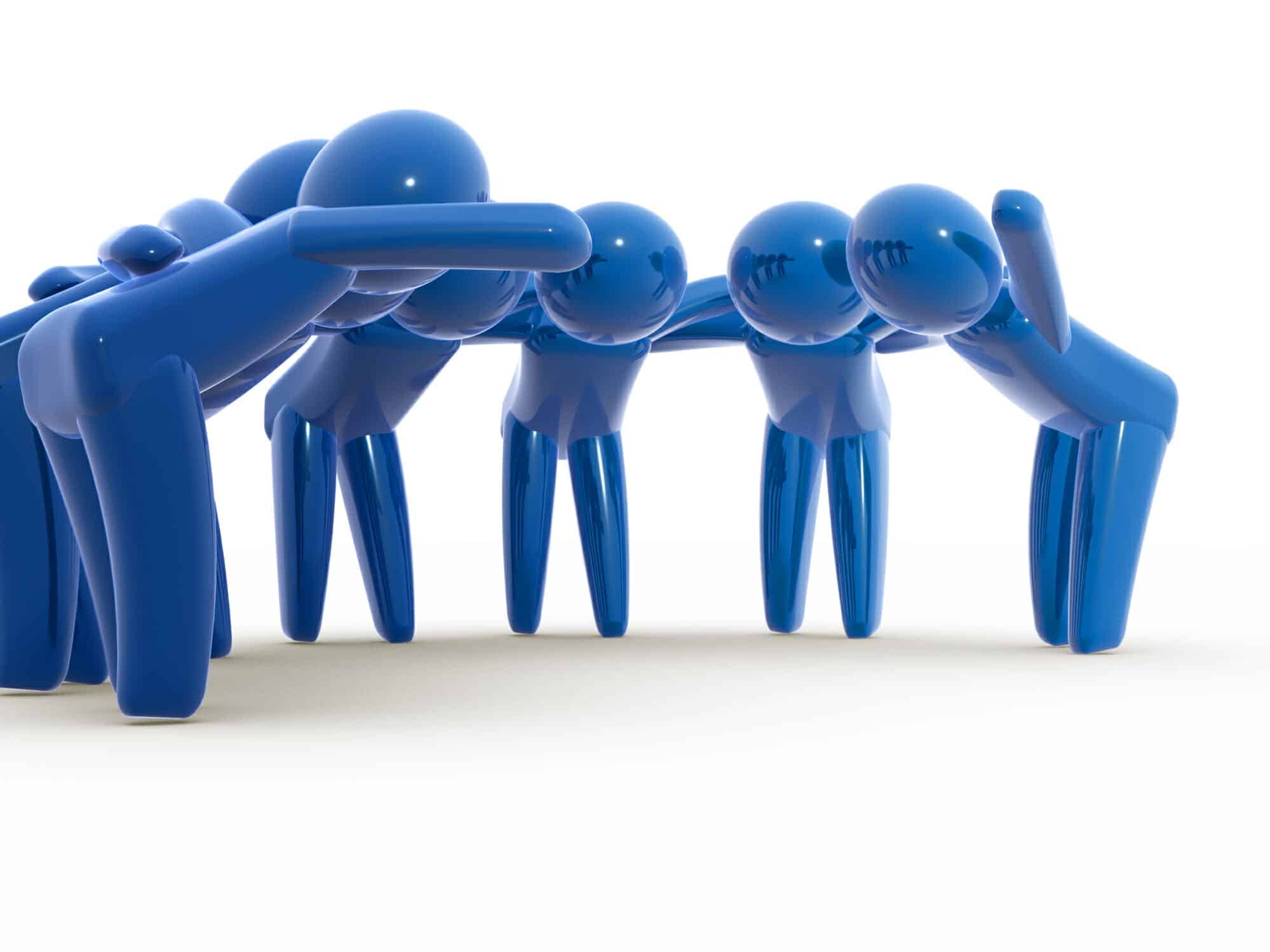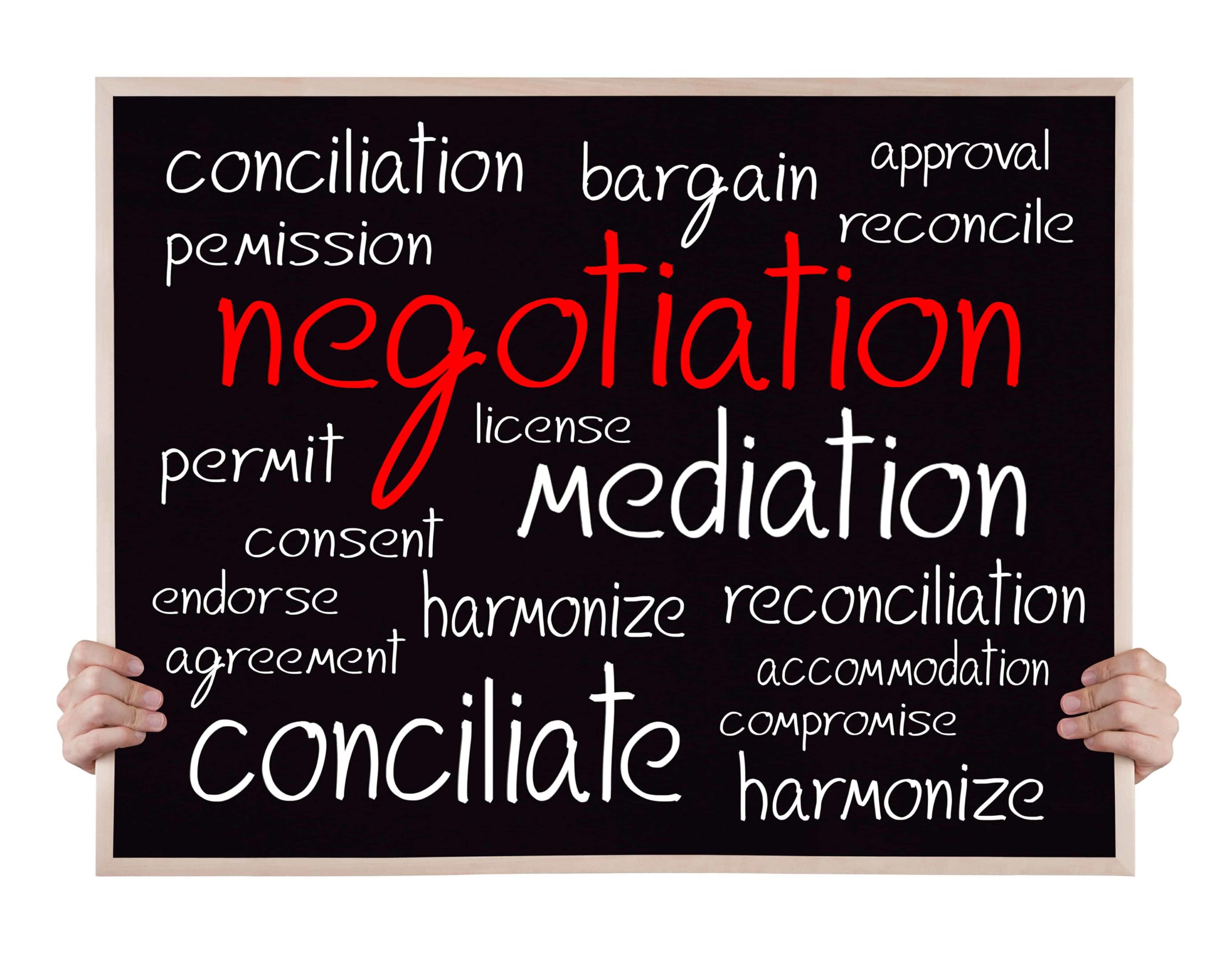Collaborative Divorce is a specific divorce process where spouses, their attorneys, and other divorce professionals work together to end a marriage with dignity and respect.
Collaborative Divorce is an alternative dispute resolution process. That means it is a more amicable alternative to fighting your divorce in court.
Collaborative Divorce negotiations happen in conference rooms, not courtrooms. The only time couples who have used the Collaborative Process go to court is after their entire case has been settled. When that happens, they simply present their divorce decree to the judge for final approval.
The Top 5 Benefits of Collaborative Divorce:
1. It’s private.
Unlike a litigated divorce, which plays out in a public courtroom, a Collaborative Divorce gets worked out in a private conference room. You and your spouse resolve your divorce issues at a series of meetings, rather than at court hearings. Your negotiations and disagreements do not become part of the public record. In short, staying out of court allows you to keep your private life, private.
2. It’s personal.
When you use the Collaborative Process, you and your spouse work with a specially trained team of divorce professionals to create an outcome that meets both of your needs AND puts your kids first. In the Collaborative Process, you and your spouse focus on creating a new family, rather than on destroying your old one. You work together to create a settlement agreement that is fair and that will last. Your divorce settlement is tailored specifically to you and your family. You are not stuck with a “cookie-cutter” anything.
3. It preserves relationships.
When you’re going through a divorce, you don’t feel like you can trust your spouse anymore. You may not feel like you even know your spouse anymore. Yet, like it or not, if you have kids, you and your spouse are going to be the parents of your children forever. It’s in your best interest – and your kids’ best interest – to learn to get along. Collaborative Divorce teaches you how to effectively communicate with your spouse during a time when most couples’ communication totally breaks down. You can then continue to use those skills to co-parent with your ex after your divorce.

4. It’s supportive.
In Collaborative Divorce, you use a team of divorce professionals to help you get through your divorce. Instead of relying on a divorce lawyer to manage your kids, your finances, and your emotions, in Collaborative Divorce you use child specialists, financial advisors, and divorce coaches. While that probably sounds expensive, because each divorce professional works within his/her area of expertise, the Collaborative Process is actually more efficient and effective than the traditional divorce litigation process.
5. Everyone’s Interests Are Aligned.
A Collaborative Divorce starts when you, your spouse, and all the divorce professionals sign a “Participation Agreement.” In that agreement, you and your spouse commit to using the Collaborative Process to resolve your divorce issues. If you or your spouse later decide to fight in court, all the divorce professionals withdraw. Then you and your spouse have to get new divorce professionals to handle your divorce from that point forward.

How Does Collaborative Divorce Work?
In Collaborative Divorce, everyone works toward a common goal: negotiating an end to your marriage that keeps you out of court. Unlike in a traditional divorce, a Collaborative Divorce is focused on meeting your family’s needs and on addressing everyone’s concerns.
Rather than creating a “winner” and a “loser,” in a Collaborative Divorce, there is just you and your spouse, separating yourselves from each other respectfully.
The Collaborative Process starts by signing a Participation Agreement. You, your spouse, and all the divorce professionals sign the same agreement.
In that agreement, you and your spouse commit to using the Collaborative Process to negotiate your divorce. The divorce professionals commit that if you stop using the Collaborative Process and you go to court, they will no longer represent you or work with you.
While that may sound extreme, the truth is that in a traditional divorce, your interests are not the same as the interests of any of your divorce professionals. All of them will make more money if you fight in court. By agreeing that they will no longer work with you if you fight in court, your divorce professionals align their financial interest with yours.
Signing the participation agreement gives everyone an incentive to keep working together amicably to resolve your divorce.

Who is on Your Collaborative Team?
Collaborative Divorce is the most supported divorce process because it uses a team approach. Unlike in a traditional divorce when the only divorce professional you may use is a divorce lawyer, a Collaborative Divorce uses a variety of professionals to guide you through your divorce.
When you think about that, it makes a lot of sense.
Divorce affects every area of your life. It is legal, emotional, and financial. It affects your kids, your family, your finances, and your relationships. Getting through a divorce effectively requires professional help in all those areas.
While most people assume that their divorce lawyer is the only professional they need, that’s not necessarily true. Most divorce lawyers have no special training in finance, psychology or children’s issues. Financial professionals and mental health professionals do.
All that having been said, you don’t have to hire a dozen professionals just to get through your divorce. Some teams can be small: they may only have two divorce lawyers and a divorce coach. Other teams can be large: they may have two divorce lawyers, two coaches, a financial neutral, a child specialist and more.
The size of your Collaborative Divorce team depends on you and your spouse. It depends on what you want and need in your divorce. It also depends upon how complicated your family and your financial situation are.

The Top 5 Most Frequently Asked Questions About Collaborative Divorce
1. How Much Does a Collaborative Divorce Cost?
As with every other kind of divorce, the answer to “How much does a Collaborative Divorce cost?” is: It depends.
Divorce professionals typically charge by the hour in Collaborative Divorce cases just like they charge by the hour in traditional divorce cases. That means that the more you and your spouse argue, the longer your divorce will take and the more it will cost.
However, because Collaborative Divorce uses a team approach, it is often more efficient than divorce litigation. That efficiency saves you money.
Since each divorce professional only handles the issues that are within his/her area of expertise, those issues are often resolved more quickly. What’s more, using the right professionals to handle each aspect of your divorce gives you the benefit of getting truly qualified advice in every area of your divorce.
Another way the Collaborative Process saves you money is because it is less formal than traditional divorce litigation. It’s easier to exchange financial information when you’re not in court. Your lawyers also don’t have to go to court every month for endless status conferences because in a Collaborative Divorce your case isn’t filed in court until you’re ready to hold the final hearing.
All of that saves you money.
Collaborative Divorce also saves you money in a less obvious, but equally important way. It helps keep you and your spouse out of court AFTER your divorce is over.
Although most people don’t realize it, a significant percentage of divorced couples end up back in court, fighting again, after their divorce is over! That doesn’t happen nearly as often with Collaborative Divorce as it does with a traditional divorce.
2. How is a Collaborative Divorce Different from Other Divorce Processes?
The biggest difference between Collaborative Divorce and every other kind of divorce is the agreement that everyone (including the lawyers) must sign at the beginning of the Collaborative Divorce process.
That agreement (which is called a “Participation Agreement”) states that if the Collaborative Process does not work, and either spouse decides to go to court, then all of the divorce professionals have to withdraw. The couple must then find new lawyers to represent them in court.
Not surprisingly, many divorce lawyers aren’t excited about signing the Participation Agreement.
Trial lawyers can give you a thousand reasons why requiring them to bail if your divorce negotiations fail. The biggest reason is that starting all over again with new lawyers is time-consuming and expensive.
Those lawyers are absolutely right.
Starting all over again with new lawyers IS time-consuming and expensive. That’s exactly the point.
When fighting in court costs you time and money, you become less likely to do it. That keeps you at the negotiating table when the negotiations get rough.
When fighting in court makes lawyers lose their clients, and therefore their fees, lawyers become less likely to stir the pot. They start looking for creative ways to end their client’s conflicts, rather than jack them up.

3. Collaborative Divorce vs. Traditional Divorce: What’s Better?
Like everything else, the answer to the question, “Which is better: Collaborative Divorce or traditional divorce?” is: “It depends.” It depends on you, your family and your situation.
The first thing you need to consider when deciding whether you want a Collaborative Divorce or a more traditional divorce is whether your spouse will be on board with your decision.
The Collaborative Process is voluntary. If your spouse won’t agree to pursue a Collaborative Divorce then you’re going to be stuck litigating your divorce.
Another important factor to consider is the level of co-operation you expect to get from your spouse.
Producing financial information in a Collaborative Divorce is voluntary. That doesn’t mean you can’t get the information you need. It also doesn’t mean that you and your spouse don’t have to produce your financial information to each other and to your attorneys. You do.
But because you’re not in court, there is no judge who will FORCE you to produce full and complete financial information to each other.
If you believe that your spouse is hiding money or won’t produce his/her complete financial information to you without a fight, then the Collaborative Process is NOT for you. (Sorry!)
Another thing you want to consider when deciding the type of divorce process you want to use is the level of control you want to have in your divorce.
When you go to court, the judge is in control of your divorce. You have to follow the court rules. You have to deal with the court’s schedule.
In a Collaborative Divorce, you and your professional team control your divorce. You work at your own speed.
If being in control matters to you, then you might want to avoid litigating your divorce in court.

4. Collaborative Divorce vs. Mediation: What’s Better?
Both Collaborative Divorce and divorce mediation are alternative dispute resolution processes. That means they are both alternatives to going to court.
In many ways, the benefits of any court alternative are similar.
Staying out of court gives you more privacy and control over your divorce. You don’t have to follow the court rules, so things can happen more quickly and with less “pomp and circumstance.” You have the freedom to be more creative in the settlement you ultimately make.
At the same time, some of the drawbacks are similar too.
Both mediation and Collaborative Divorce are voluntary processes. If your spouse won’t agree to participate in them, they won’t work.
Sure, some judges will ORDER you and your spouse to go to mediation, or to mediate certain issues. But, while a judge can force you to go to mediation, s/he can’t force you to make an agreement. So if either you or your spouse won’t mediate in good faith, mediation is useless.
But even though Collaborative Divorce and mediation are similar in many ways, they are also different. The primary difference is the level of support that each process gives you.
If you mediate your divorce, your attorney may not be present with you during your mediation sessions. In the Collaborative Process, your lawyer will usually always be with you while you’re negotiating.
In mediation, you won’t normally have a divorce coach or financial neutral present. That means that you won’t have someone in your mediation session who can help you diffuse tense negotiations. You also won’t have a financial person present who can advise you of the financial implications of your settlement options.
The bottom line is that mediation is less supported (and less expensive). Collaborative Divorce is more supported (and usually more expensive).
5. How Long Does a Collaborative Divorce Take?
Like every other divorce process, the length of time a Collaborative Divorce takes depends on how much you and your spouse argue and fight. The more you argue and fight, the longer your divorce will take.
While lots of people think that in Collaborative Law, no one fights, nothing could be further from the truth!
Just because, in a Collaborative Divorce, you are trying to end your marriage in a more respectful way, that doesn’t mean for a moment that you and your spouse will always automatically agree on everything!
There is conflict and disagreement in a Collaborative Divorce just like there is in any other kind of divorce.
The difference lies in how the conflict is handled.
Instead of allowing disagreements to escalate into battles, Collaborative Divorce Coaches help divorcing spouses navigate their disagreements more peacefully. They help divorcing couples manage their emotions and discuss their disagreements calmly. That keeps the level of conflict down.
Unlike in a traditional divorce, lawyers in a Collaborative Divorce also help reduce – rather than increase – conflict. Because the Collaborative Lawyers know they will lose their clients if they end up fighting in court, the lawyers encourage clients to act rather than just react. They don’t have the same incentive to escalate emotional situations so that divorces take longer and cost more.
Even still, if a couple has a lot of issues to resolve, or insists on fighting about everything, their divorce will take time. That’s true no matter which divorce process they use.

Who Should Use Collaborative Divorce?
Collaborative Divorce is an excellent way to resolve your divorce. But it’s not for everyone.
The people who will get the most from Collaborative Divorce are people who:
1. Care about their privacy.
If you’re a celebrity, fighting your divorce in court can turn it into a circus. Even if you’re not quite so well known, you still may not want the details of your personal life memorialized forever in the public record.
2. Want to Do What's Best for Their Kids.
Conflict hurts kids. Because Collaborative Coaches help you and your spouse learn to communicate better, you will have a valuable tool that will help you co-parent better. What’s more, Collaborative Child Specialists are trained to help you understand what will be best (and worst!) for your kids during and after your divorce. They can help you avoid common parenting pitfalls as you go through your divorce process.
3. Want to be in control of their divorce.
If you’re not the kind of person who is fine with allowing someone else to drive your life, then Collaborative Divorce is for you. It will allow you to actively participate in your divorce, while still giving you the support you need.
4. Don’t have the same financial knowledge.
When one spouse knows more about a couple’s financial situation than the other, the less knowledgeable spouse is at a disadvantage during financial negotiations. The same is true if one spouse just doesn’t know a lot about personal finance, period. Collaborative Divorce is the only divorce process that includes a neutral financial professional bakes into it a specific mechanism for helping the less knowledgeable spouse educate him/herself about how finances work. The neutral financial professional can help educate and empower the less knowledgeable spouse to make better financial decisions.
5. People who have been married for a long time.
People who have been married for decades have a lot of history together. Their families tend to be more established and entwined. Their finances tend to be more complex. What's more, if they're getting a divorce after 50 the issues they are facing will be different than the divorce issues for younger couples. Using a divorce process that provides them with significant support and gives them a way to discuss their issues more constructively can help them end their marriage more amicably.
The people who should NOT use the Collaborative Process are people who:
1. Would rather have their lawyer do everything for them.
If you want to take a “hands-off” approach to your divorce, the Collaborative Process is NOT for you. The same thing is true if you want your divorce lawyer to negotiate everything for you. Collaborative Divorce requires you to participate in your own divorce. If you’re not down with that, this process won’t work for you.
2. Have a spouse who is extremely difficult, dishonest and/or hiding money.
If your spouse refuses to come clean with financial information, this process won’t work for you. If your spouse is hiding money and purposely trying to cheat you, this process won’t work for you. Finally, if your spouse refuses to agree to anything just to spite you, then you’re going to have to litigate your divorce.
3. Don’t want to learn about their finances.
Ignorance may be bliss, but in divorce, ignorance (especially financial ignorance) is expensive. If you think learning about your personal finances is too hard, or too complicated for you, then any alternative dispute resolution process won’t work for you. Your best bet is to hire a lawyer, have the lawyer do everything for you, close your eyes, cross your fingers and hope for the best. Maybe things will turn out okay. (… or maybe not!)

4. Have marriages involving domestic violence.
While some practitioners may use the Collaborative Process in domestic violence cases, most will not. Domestic violence victims generally don’t feel free or empowered enough to help negotiate their own divorce. The power imbalance between the victim and the perpetrator is just too deep and too great.
5. Want to fight.
Some people want their “pound of flesh.” They want to make their spouse suffer. They don’t care how long their divorce takes or how much it costs. As long as they can show the world what a shit their spouse is, they’re happy. If that’s you (or your spouse), you’re going to have to fight your divorce in court. Sorry.
Is Collaborative Divorce Right for You?
Collaborative Divorce can be a powerful alternative to litigating your divorce in court.
If you're considering a Collaborative Divorce, make sure to arm yourself with plenty of information and hire a good Collaborative Divorce Attorney in your area.
To find Collaborative Divorce Professionals in Illinois, go to the Collaborative Divorce of Illinois website.
If you need to find Collaborative Divorce Professionals in other states, go to your local Collaborative Law Organization, or check out the International Association of Collaborative Professionals.
